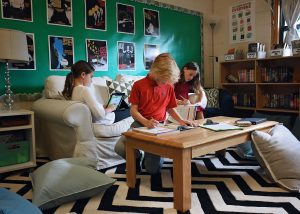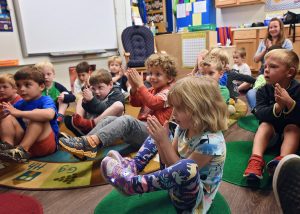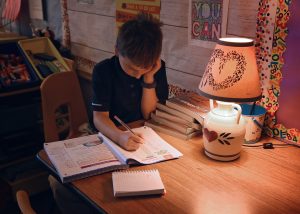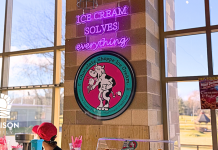 Imagine walking into your favorite place. Is it somewhere in nature? A certain room in your house? A favorite store? Now imagine your child’s favorite place. What about these spaces make them your favorites? I’m sure that it has something to do with how they make you or your child feel. Perhaps it’s the type of furniture in the space, or lower, less harsh lighting. It might also be how you get to interact with the spaces, whether it be in groups, by yourself, or a little of both. Our environment can greatly impact our mood and our ability to focus, and our children’s learning environments significantly impact their experience while at school each day. It is important for these learning spaces to serve as an oasis amidst the busyness. So what does it take to create a warm, relationship-centered, inviting learning environment, and why do we need to make the shift at all?
Imagine walking into your favorite place. Is it somewhere in nature? A certain room in your house? A favorite store? Now imagine your child’s favorite place. What about these spaces make them your favorites? I’m sure that it has something to do with how they make you or your child feel. Perhaps it’s the type of furniture in the space, or lower, less harsh lighting. It might also be how you get to interact with the spaces, whether it be in groups, by yourself, or a little of both. Our environment can greatly impact our mood and our ability to focus, and our children’s learning environments significantly impact their experience while at school each day. It is important for these learning spaces to serve as an oasis amidst the busyness. So what does it take to create a warm, relationship-centered, inviting learning environment, and why do we need to make the shift at all?
Science Behind “The Space”
Making these changes to how our schools and learning spaces are set-up, comes in response to an overall shift in the style of teaching and learning that students need. This shift in education creates organic learning opportunities that foster the life skills necessary for our students to be successful and celebrate their individual strengths. These 21st-century skills of collaboration, communication, creativity, and critical thi nking require a space that supports and sustains this style of teaching and learning. Gone are the days of students sitting in the same spot for 8 hours a day. Rather, there is a shift to design learning environments that feel warm and personalized that respond to the learning needs of our students.
nking require a space that supports and sustains this style of teaching and learning. Gone are the days of students sitting in the same spot for 8 hours a day. Rather, there is a shift to design learning environments that feel warm and personalized that respond to the learning needs of our students.
What Does a Responsive Learning Environment Look Like?
Responsive, or flexible, learning environments can look a multitude of ways. Really, it is all about how the space makes you feel in reference to the learning that will be taking place there. For example, when students are working together and communicating, they are naturally more mobile. The learning spaces in this instance could be made up of different pockets of space. Sometimes this looks like having sitting areas of varying styles, heights, materials, and comfort. In some rooms, this may look like having a combination of soft seating options, moveable stools, tables and desks of varying heights, desks or tables with the legs removed so that students can sit on the floor on a cushion, or even a couch or comfy chair. The learning space transforms into something that resembles a more inviting and comfortable experience. Other spaces might have alternative options for helping students’ bodies to be able to focus better in response to a need to have movement while still remaining tuned in for learning. These spaces would have things like rockable stools, exercise balls, wobble cushions, or even stand up desks with a moveable leg bar. 
In addition to the spaces’ furniture, there are other ways to help set the stage for creating a responsive learning environment for students. Many classrooms are starting to dim the harsh overhead lights, and use softer warmer lighting such as lamps and twinkle lights to help create a more calming space. (Just imagine how much more soothing that next trip to Target would feel if it was set with calming mood lighting?) These spaces also use a variety of instrumental music and visuals such as virtual fireplaces or aquatic scenes and timers to help students not feel rushed. It is our job as educators and parents to help respond to this need for change.
What We Do At Queen of Peace
The teachers and staff at Our Lady Queen of Peace School strive to create learning environments that balance the needs of all of our students. We weave together components of traditional classroom environments with a more responsive and flexible classroom set-up in order to create a tapestry of educational excellence. While walking the halls on any day, it is not uncommon to walk past a room with the overhead lights off and a fireplace crackling while the students are designing a presentation or writing. Students might be filming in front of green screens in the hallway and in their classrooms or coding robots on expeditions in the hallway. There might be students working on social studies in their classroom, but they may be “sitting around the room”, some on a couch, some on cushions on the floor, some at standing desks, but all in the same classroom. Our early childhood and primary classrooms might be in small groups at tables while others are reading around the room on wobble cushions. At Queen of Peace School, we always feel like our students have the opportunity to learn in a space that feels like home, and we find that students are better engaged because they are able to take ownership and find a way to learn that truly feels right to them. 
*****
If Queen of Peace sounds like it could be a good fit for your family’s learning needs, please join us at our upcoming Open House on Sunday, January 26, 9:00am-1:00pm. There will be activities throughout the classrooms, and teachers, as well as current parents, will be on hand to answer any questions you may have. Queen of Peace School is located at 418 Holly Ave, Madison, WI 53711. If you would like to schedule your own private tour please call us at 608-231-4580.
For more information about Queen of Peace, please visit our website or Facebook page.












